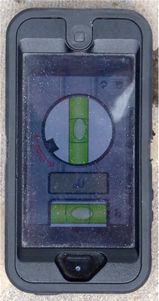On the Equator!
Saturday, July 11, 2015
 |
We reached the Equator, labeled as zero latitude by GPS determination. |
They had a number of displays set up along the Equator line to demonstrated the nature of zero latitude. |
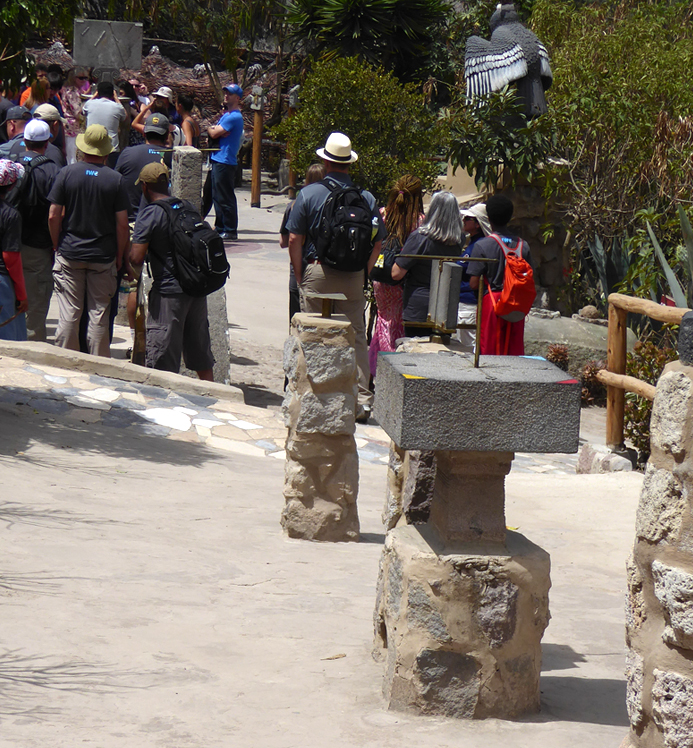 |
 |
Fairview Church group from Garner, NC. A great place for a group picture on the Equator. Kaleigh and Grayson from this group were on our Crew #5. |
The Equator was marked with this line of red bricks. On that line we wanted to deal with all the Equator stories. |
 |

The Northshore group at the Equator!
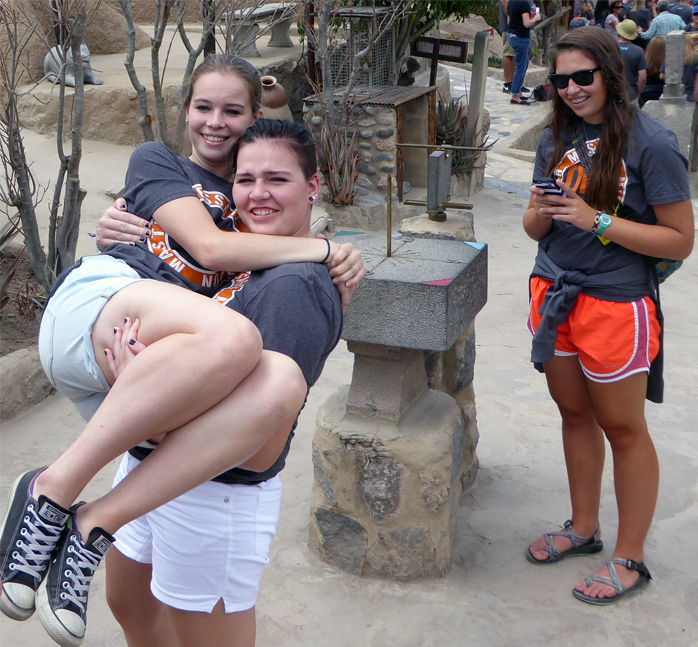 |
One of the Equator stories is that you get weak at the Equator and can't lift a load that you easily lift a few feet off the Equator. So Alex lifts Ashleigh right on the Equator with Abbie as witness. Hmm! I thought the story might come from a fatique factor, so I lifted Dustin on the Equator first and then off the Equator, and couldn't tell any difference. |
Ashleigh and Jordan on the Equator! The big concrete ball at right appears to be a replica of the Equator ball at the location some miles away which marks the Equator. |
 |
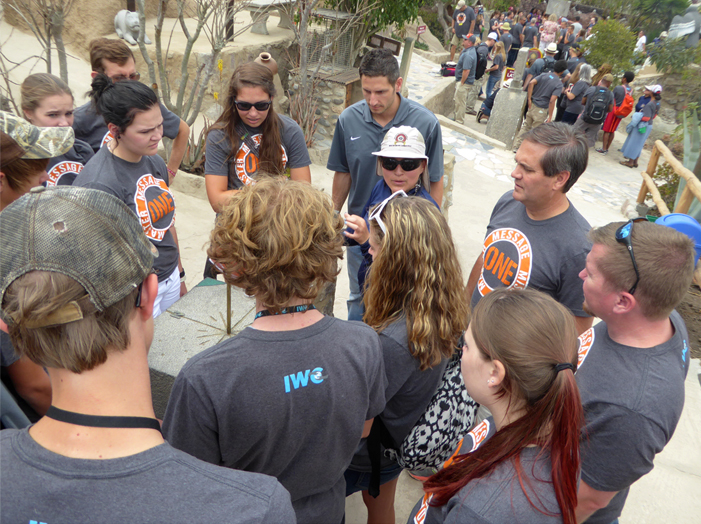 |
Our guide took us to the different displays and explained them. A vertical rod on the Equator will cast no shadow twice a year when the sun is directly at the zenith point. |
Our groups cycled through the Equator displays with explanations from our guides. |
 |
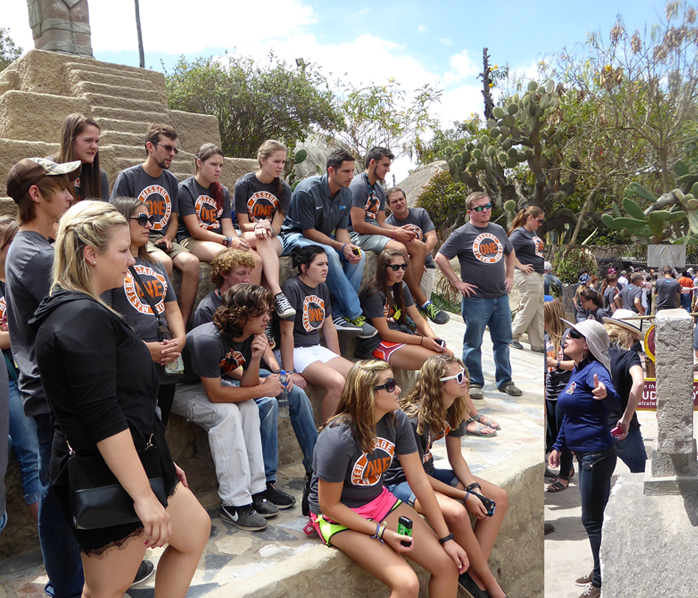 |
Our guide demonstrated the solar clock or sundial at the Equator. |
It was a privilege to be able to say that you have stood on the Equator. |
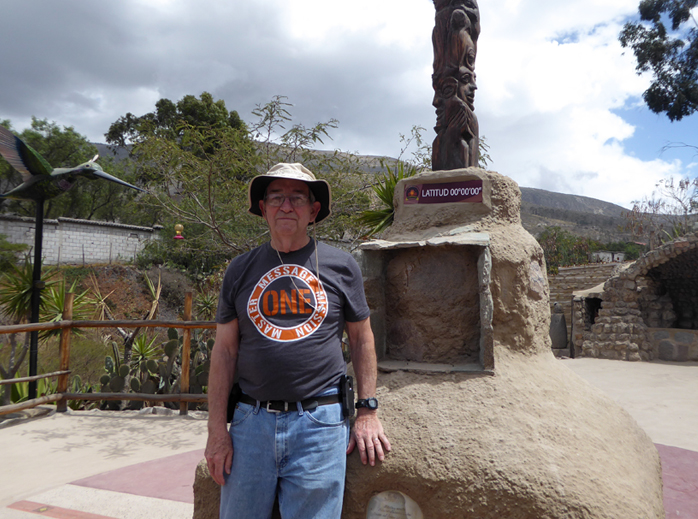 |
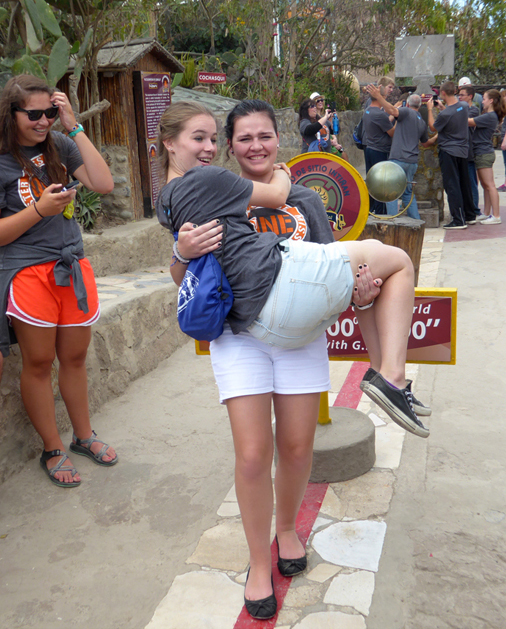 |
Another Equator story is that you can't walk the Equator line with your eyes closed. So Alex is walking it with eyes closed and also carrying Ashleigh to take out two myths at one time. Abbie is their witness again. The Equator stories do generate a lot of discussions. It looks like there is an active discussion going on behind Alex and Ashleigh. 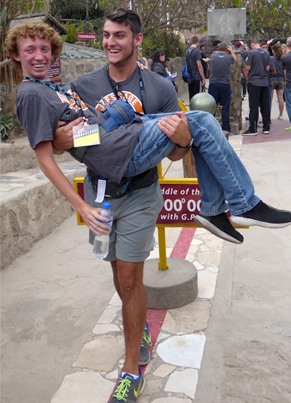 |
Jordan is in the Northern Hemisphere of the Earth and Ashleigh is in the Southern Hemisphere. Granddad is doing his best to straddle the line! 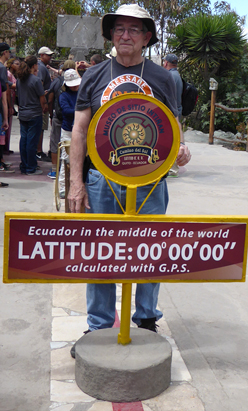 |
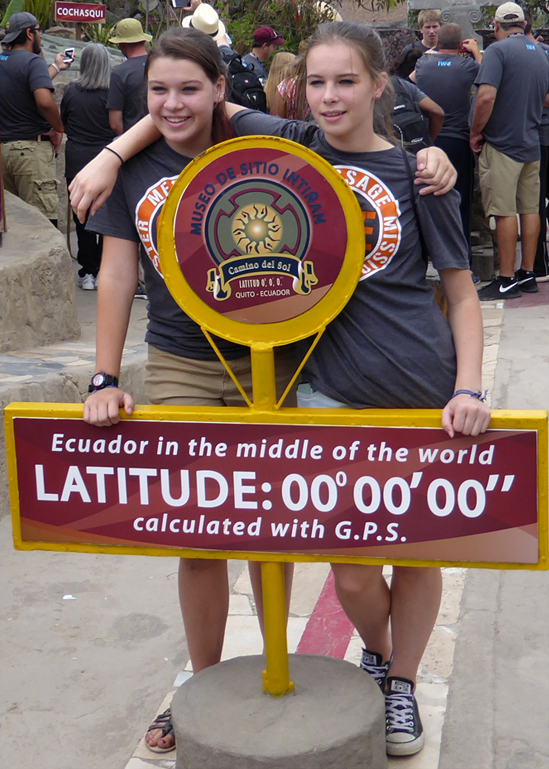 |
 |
Jordan, Rod and Ashleigh on the red line that marked the precise equator line. |
Note that the shadow is almost perpendicular to the Equator line. The same is seen on the inset photo about the same time. So it must be noon, right? There are two times of the year when the sun would be directly overhead and there would be no shadow at noon. Hmm! The clock on the camera reads 12:58 local Quito time. I don't know if that means daylight savings time, or if the choice of official time zone offsets an hour, or what. |
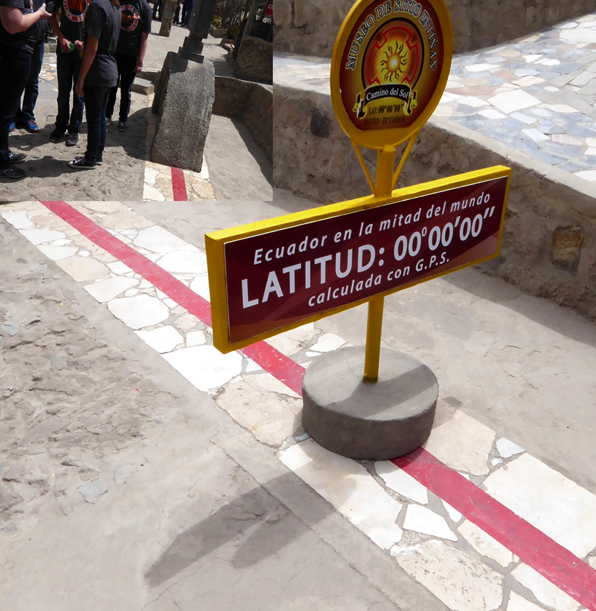 |
 |
This brought us to one of the most discussed Equator stories - that water will swirl counterclockwise in the northern hemisphere when going down a drain, and clockwise in the southern hemisphere. Our guide put the rounded-rectangular basin right on the equator, poured water in it, and pulled the plug. It quickly drained out without any indication of rotation. She had a few small leaves to sprinkle in the water to give a more sensitive observation of any rotation of the water. |
| The next step was to move the basin about six feet south of the Equator line and pour water in again, and this time the water clearly rotated clockwise, with the rotation becoming more prominent as the last water approached the drain. Again, this was made easier to see by the dropping of the small leaves in the water.
Then, the basin was moved about the same distance north of the Equator line and water was poured in again. This time the water clearly rotated counterclockwise, with that motion becoming more prominent for the water closest to the rotation axis as it went down the drain. Sure enough, as air masses in the Northern hemisphere are driven by the net pressure toward a low pressure area, they will take on a counterclockwise rotation around the low pressure area. This is attributed to the Coriolis effect, an effective force arising from the rotation of the Earth about its axis. It is a major contributor to air motion patterns on the rotating Earth. In the Southern hemisphere, the Coriolis effect drives the air masses into a clockwise motion about a low pressure area. So the same thing should happen to water going down a drain, with counterclockwise rotation in the Northern hemisphere and clockwise rotation in the Southern hemisphere. Right? The other concept that makes this scenario attractive is demonstrated by sitting on a rotating stool while holding masses out, and then pulling the masses inward. As you pull the masses closer, you will spin faster. So if you have a small amount of rotation when the mass is far from the axis, it will be enhanced as the mass moves closer to the spin axis. Just like the water in the little gold basin, right? The problems arise when you try to quantify the Coriolis effect - it is found to be extremely tiny in situations like this, and a slight amount of rotational momentum from any other cause will typically be far larger than the contribution of the Coriolis effect. |
|
The question in this case is, what is producing the slight clockwise fluid motion when the basin is south of the Equator? If a slight clockwise angular momentum is given to the water when it is far from the drain, that circulatory motion will be enhanced as it moves toward the axis of rotation, the drain. Likewise, if the slightest counterclockwise motion is imparted to the water when it is in the northern position, that counterclockwise motion will persist and be enhanced as the water moves toward the drain. There is a YouTube video at coriolis effect at the Equator. You can also Google for "coriolis effect on drains" and get covered up with material. One consensus is that it is easier to reproduce the effect shown in the video by using a rounded rectangular basin rather than a circular one. A slight angle to the left and an entry point slightly to the right of center will give you counterclockwise rotation which will be subtle. You need to pull the plug fairly quickly before that slight rotation settles down, and then the rotation will be enhanced as it moves toward the drain. If you watch the video, note that on the Equator, the water is poured in and allowed to sit for a significant length of time. That's because any tiny circulatory currents will be enhanced when you pull the plug, and you are trying to show that there is no rotational effect right on the Equator. It would be interesting to have the candid stories of the guides about how they developed their technique to reliably get the desired direction of rotation N and S without making it obvious.
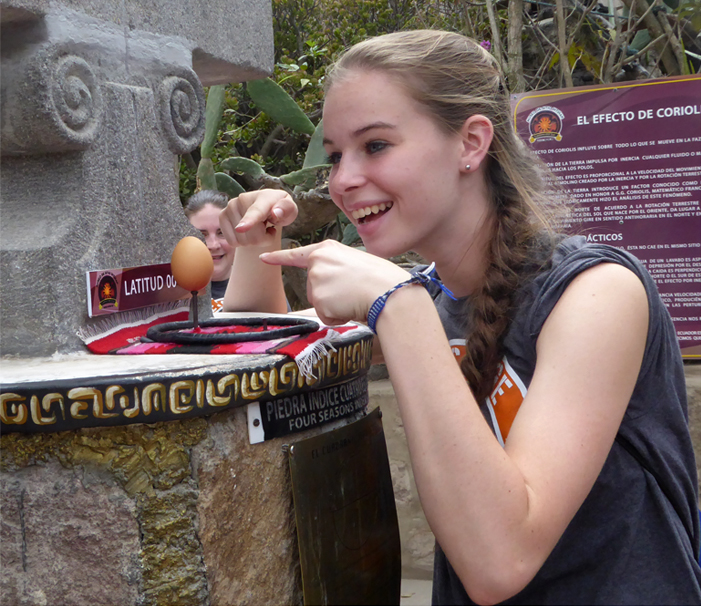 |
Ashleigh balances an egg at the Equator!Not everyone who tried was able to do it. It took some patience. Luis was able to do it, and Ashleigh seemed to do it very quickly. She even did it on the high nail! Note that there is a lower nail provided to the right of the one she balance the egg on. |

The story that you can balance an egg exactly at the Equator but not at other places is a pervasive tale and is accompanied by another tale that you can balance an egg in the Northern hemisphere on the moment of the Vernal Equinox when the sun is most nearly overhead (crossing the meridian). These stories have received a lot of attention and experimentation. There is a Wikipedia article on egg balancing which gives a lot of the interesting lore about it.
 |
The final of the Equator stories with which we were presented was the story that you can hold your arms out against a downward pull off the Equator, but become weak right on the Equator and can't do it. This is actually the most puzzling of the stories to me. Abbie, Michael and Dustin are going to try it. |
 |
 |
All of them were able to offer resistance to having their arms pulled down at the location a few feet off the Equator. Our guide placed them on the Equator line, and was able to easily pull their arms down. Story confirmed, right?
Alright, I'm going to have to try this. I was suspicious that this might be a fatigue effect, that after resisting strongly you might have depleted the glycogen in the key muscles and might not be able to resist the second time. So I got on the Equator first and had Jordan pull my arms down and then moved off the Equator and had her pull again. The results were somewhat ambiguous, so I had her try again in the standard way with me off the Equator first and then on the Equator. On the Equator she was able to pull my arms down easily and repeatedly, and I was surprised. So, walking away from that, I was having the same experience as the others, that they seemed to lose the capacity to resist the downward pull on the Equator, and that was mysterious.
There is an interesting account on the web entitled Why-did-my-muscles-turn-to-jello-on-the-Equator. It's consistent enough with my experience to quote:
"Please .. accept these observations as true and accurate. I acknowledge that I'd have a hard time believing them if I hadn't been there myself and experienced it. This was a strength test. Our guide had a visitor clasp his hands and raise them high up in front of his head while he was standing about 5 feet north of the equator. She then attempted to pull down his arms (after instructing him to resist) and was unable to do so. They then repeated the experiment with him straddling the equator line. This time she was able to pull down his arms with relative ease. They then did another similar experiment. Five feet north of the line, the guide had the visitor form a circle with his thumb and forefinger and she attempted to pull the fingers apart (after instructing him to resist). She was unable to do so. Again, this was repeated with him straddling the line and this time she was able to easily pull his fingers apart.
Now I'm not stupid, and would have been totally convinced that the guy was a plant except for the fact that there is simply no way to fake the look on his face. That left only one possible explanation -- the guide was simply not trying as hard north of the line as she did on the line itself. Only one way to test this...I had my wife try to duplicate the experiment with me (everyone else started doing this as well). We walked north of the line and my wife was unable to pull my arms down or separate my fingers. We then went to the line and to my extreme astonishment, my arms just fell and my fingers just separated...offering up no resistence. There were about 10 other people there, and this held true without exception. I was (and remain) STUNNED and I simply cannot explain this. I've even thought that maybe some psychological factor could be involved (after the initial demonstration we expected it to be true, so we made it be true, or some such), but I really don't think so. Instead, I ask my fellow readers....Can anyone explain this mystery?"
After frankly admitting that I can't explain either his experience or mine, that doesn't keep me from speculating. One physiological fact is that you can't support much weight at the end of your arms extended like that because they form a lever that works against the muscle support points of your shoulder joint. I use a typical example of being at a torque disadvantage by trying to lift a board by its end. Rough measurements of my own shoulder suggests a maximum lever arm of about 3 inches for my shoulder, and a length of about 27" for my arm, so at the end of my arm a weight has a 9 to 1 mechanical advantage over the muscles of my shoulder. So if a person exerted a 30lb downward force on my hands, my front shoulder muscle support point would have to exert an upward force of 270 lbs to balance it. No way! So even if a 30lb child jumped up and hung onto your hands, you could not support it.
So why does the Equator scenario seem so surprising to what I would surmise is the majority of the people who try it? I don't know! It seems like in this extraordinary setting of the Equator both parties are in some sense buying into the story. It is physically clear that by just hanging or exerting your muscles on the end of the other persons arms in a direct way so that your muscles have this clear advantage, you can pull the other person's arms down whether they are on or off the Equator. I can't identify anything physical that is significantly different if you are on the Equator or off it by that short distance.
| Continuing the Equatorial exploration |
2015

